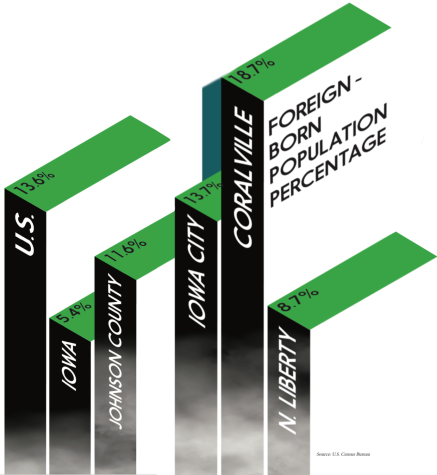Your donation will support the student journalists of West High School. Your contribution will allow us to purchase Scholarship Yearbooks, newsroom equipment and cover our annual website hosting costs.
The Journey
November 17, 2022
While most immigrants seek a better life when moving to a new country, motivations behind the move are different for each person. Economic opportunities play a major role for many, including Didier Kasongo ’23 and his family who emigrated from the Democratic Republic of the Congo to the U.S. in 2018.
“My parents came here first [and sent] money to me, so I could come,” Kasongo said. “[In the DRC,] we didn’t have money, and then when we came here, everything changed … Better jobs, better money, better life.”
Others make the journey to pursue alternative educational opportunities. Isabel Garcia Rascon ’25 came to the U.S. from Mexico at the start of the school year. She believes this education will give her better opportunities in the future.
“I came here because I wanted to learn English, but I plan to return to Mexico,” Garcia Rascon said. “Learning English opens more doors in Mexico — more work and more schools.”
Nomi Wang ’23 emigrated with her mother from China right before this school year for better educational opportunities as well.
“[My mom was] always talking about [how] she [wanted] to send me to either [an] international school in Shanghai or just wanted me to come to the U.S. as soon as possible, so when she told me, ‘Hey, you have the chance to come with me to Iowa,’ [I took] it,” Wang said. “I think America will be a better place for my own development, both in academics and other stuff.”
Chances for economic and educational growth can also be a push for people to emigrate from the U.S. to another country.
After spending the first 10 years of his life in Milwaukee, Wisconsin, Bashir Eltyeb ’25 and his family decided to move to the United Arab Emirates. Since then, they immigrated to Sudan and then ultimately returned to the U.S. Employment was the deciding factor in Eltyeb’s family’s first move.
“My parents left the U.S. to go to the UAE because [of] jobs, basically,” Eltyeb said. “My dad is an electrical engineer, and the UAE is still a growing country … So there’s a high demand for [electrical engineers].”
Additional opportunities aren’t the only factors immigrants take into consideration. According to Eltyeb, family was the main reason his family went from the UAE to Sudan.
“Sudan is our home country,” Eltyeb said. “My extended family is all there like my grandma, my uncles, my aunts. Some do live here, but most of them are back there.”
Eltyeb and his family moved back to the U.S. from Sudan this August due to political instability.
“At the end, safety issues from crime forced us out,” Eltyeb said. “I got beat up by the military. One time we got robbed, me and my friends. We got a machete pulled on us … I told my parents, and they were like, ‘Yeah, this is not a place we can stay.’”
Forced migration occurs when a person moves to avoid conflict, violence or natural disaster. Immigrants who have experienced forced migration are refugees, but the requirements for official refugee status and being granted asylum vary from country to country.
University of Iowa professor Bram Elias leads the Immigration Advocacy section of the University of Iowa Legal Clinic, which provides free legal representation for people who need it. According to Elias, in order to qualify for asylum in the U.S., the individual must have a well-founded fear of persecution on account of race, religion, nationality, political opinion or membership in a particular social group.
“Being afraid of being persecuted or tortured or having something really bad happen when you go home, that’s part of what you need [to get asylum]. But, that’s not all of what you need,” Elias said. “It turns out that for the law, why you are being persecuted matters a lot.”
For those looking to become a lawful permanent U.S. resident, three other ways exist: the Diversity Visa Program, employment sponsorship or family relationships. The Diversity Visa Program is a lottery that grants permanent residence to 50,000 immigrants annually from countries with low levels of immigration.
According to the Migration Policy Institute, the most common pathway is through family relationships, with 45% of green card holders in 2020 being immediate relatives of a current lawful permanent resident.
“If you have a close family connection to any U.S. citizen or sometimes a green card holder … you can use that family connection, and that’s a way for you to apply for a green card,” Elias said.
After obtaining a green card, immigrants can legally stay in the U.S. for as long as they want, but they are not yet U.S. citizens.

“Once you stay here for a period of time, usually five years, then you’re eligible to apply for citizenship,” Elias said. “You take a naturalization test to see if you speak English well enough and if you know enough about American history. Then if you pass the test, you take an oath. Then you’re a citizen for the rest of your life.”
The Immigration Advocacy section of the University of Iowa Legal Clinic works on all types of cases regarding U.S. immigration and the naturalization process.
“There are some cases where the government’s trying to deport someone from the United States, and winning is stopping them. There’s other cases where one of our clients has a complicated path from where they are right now to becoming a citizen, but they want to become a citizen,” Elias said. “We’re not fighting against the government. We’re just helping [immigrants navigate] the process.”
